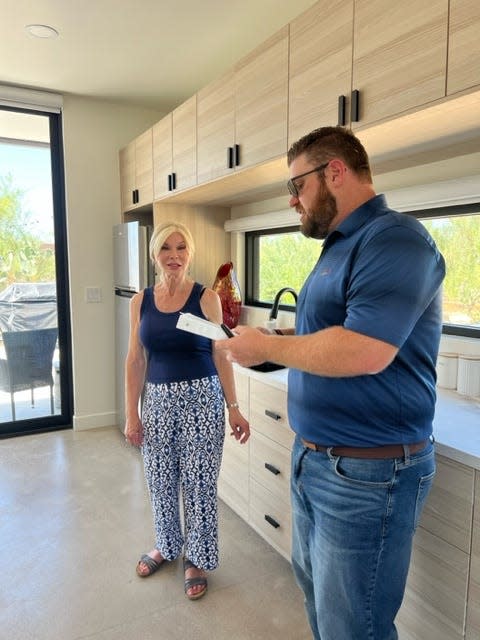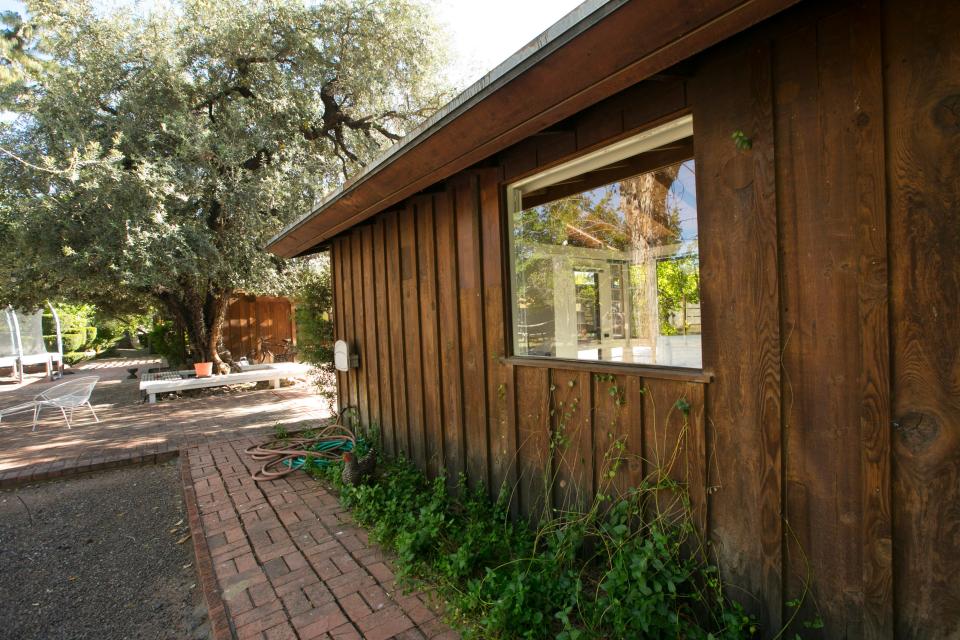Can I build a guest house or casita on my property in metro Phoenix? Here's a city-by-city guide
Days after Phoenix leaders voted to legalize backyard guesthouses citywide, a handful of other Valley cities say they may consider broadening their own zoning rules on casitas.
Most already allow guesthouses, also known as accessory dwelling units or ADUs, on larger residential lots with setbacks, height limitations and other restrictions.
But Francisco Heredia, vice mayor of Mesa, said he wants his city to create more flexible policies for ADUs in the wake of Phoenix embracing casitas.
He proposes increasing size restrictions on the buildings and streamlining the permitting process for residents, saying there's an "opportunity" to make it easier for residents to build guesthouses. He anticipates that council members will take on discussions about ADUs later this fall, he said.
In the West Valley, Peoria Planning Director Chris Jacques said that the city could be open to broadening its ADU policy "as part of local discussion on how to best address housing affordability." Still, formal consideration of the idea requires additional policy discussions with city council members and other stakeholders, he said.
The cities' interest comes amid a region-wide affordable housing crisis. The Valley's housing affordability dropped to a new low last year, despite dips in home prices and rents. Arizona also saw a 23% increase in its unhoused population between 2020 and 2022, according to federal data, and experts estimate that the Phoenix metro area is short about 150,000 to 250,000 homes.
At the moment, solving the problem lies largely in the hands of city governments. Each municipality has its own zoning laws that regulate what types of construction can be built on specific pieces of property, creating a patchwork of rules for housing creation across the Valley.
Maricopa County controls zoning in unincorporated areas of the region, but those areas are largely found on the outskirts of the metro area and tend to be more rural. Meanwhile, a series of bills that would have overhauled municipal zoning in an effort to address affordable housing challenges failed in the state Legislature earlier this year.
Phoenix officials said they see guesthouses as a tool to attack that problem, although council members said they don't expect their new policy on the guesthouses will serve as a fix-all.
As Valley cities think about possible solutions to the region's housing issues, here, from A to Z is where each one currently stands on ADUs.
Avondale
Avondale’s city code allows guesthouses in some residential zoning districts. They cannot be leased separately from the property's primary house or have a different utility service.
The floor area of an ADU cannot exceed 50% of the floor area of the main house.
Guesthouses must also have a similar architectural style and color as a property's main home and cannot exceed 15 feet in height.
Buckeye
Buckeye’s city code allows for ADUs in rural residential, planned residential, and for any single-family lot that is at least 3,000 square feet.
The difference between each single-family residential district comes down to the size of the lot as well as density.
Several stipulations come with the ordinance. ADUs cannot be located within 10 feet of the property's primary house and cannot take up more than 50% of the rear setback. It can’t be larger than 33% of the main house’s total floor area. Guesthouses also can’t have a separate utility service and can’t be taller than the primary house.
Chandler

Chandler’s rules allow for one casita per residential lot, although the guest house can’t have a stove or any cooking facilities.
The casita also cannot be in front of the property's main house, take up more than 30% of the yard or be more than 15 feet tall. Its design has to match that of the primary home and it must be connected to normal utilities, like water.
Gilbert
Gilbert’s land development code allows for a secondary dwelling unit on one lot in most single-family residential zoning districts.
The code allows it to have full kitchen and a front door that can’t be visible from a public or private street. Rentals of the secondary dwelling are permitted by the code. The second unit must use the same utility services as the primary residence and one off-street parking space must be provided in conformance with parking regulations. The design of the unit must be compatible with the primary home.
Gilbert does not have any size restrictions for the secondary dwelling unit.
Glendale
Glendale allows ADUs in agricultural, rural and suburban zoning districts, but permitting for the units depends whether they are occupied long-term or temporarily. If the dwelling unit is occupied less than 90 days per year, the unit is subject to administrative review. If the unit is occupied 90 days or more, a conditional use permit is required.
ADUs are not allowed in urban residential districts in Glendale.
Goodyear
According to Goodyear’s city code, guesthouses are permitted in residential districts as long as the lots are at least 15,000 square feet. The floor area of a guesthouse cannot exceed 50% of the total area of the property's main house, and both buildings can’t exceed 60% of the total area of the lot.
Guesthouses also cannot be leased or rented or have a separate utility service. They must be under 20 feet in height and have a similar color and architectural style to the main house.
Litchfield Park
Litchfield Park’s city code allows for habitable accessory buildings in single-family residential districts. The building can only be used by family, domestic help or temporary guests.
They can also be used for noncommercial workshops or pool cabanas. They cannot have cooking facilities or a separate utility service and cannot be leased separately.
Guesthouses cannot be more than 15 feet in height or exceed the height of a property's main house. They must also have a similar color and architectural style to the main house. A building permit is required.
Mesa
Mesa's city code has allowed for one accessory dwelling unit within all single-family residential areas since 1939. Through the years, that policy has gone through various restrictions and approval requirements, and in 2018, the city updated its policies to relax some of its more restrictive permit rules.
Casitas can be detached or attached from the primary home with electric service and “may function independently of the primary dwelling by means of separate access.” The city requires ADUs to not be visible from the public right-of-way and they must comply to setback, height and lot rules according to zoning district requirements.
Guesthouses also shall not exceed 30% of the roof area of the property's primary unit, except within the town center redevelopment area or within an infill district that allows up to 50% of the roof area. ADUs must be served by the same water service as the primary residence.
While city code allows for casitas, home association rules supersede the zoning code, which may prevent some residents from building guesthouses, a city spokesperson said.
Peoria
Peoria does not permit ADUs on a citywide level, but does allow guesthouses in agricultural and single-family residential districts where the lot size exceeds 18,000 square feet.
Those units can be as tall as 25 feet. ADUs that exceed nine feet in height or 300 square feet in area must meet the required setbacks of their respective zoning district and must conform to the city's design standards.
Phoenix

Phoenix officials approved zoning rule changes on Sept. 6 and the city now allows casitas in the backyards of all single-family homes. Previously, the city only allowed guesthouses on large residential lots.
Casitas are subject to size restrictions. They can't be more than 75% of the size of the property's primary house. On a 10,000-square-foot lot, an ADU can be a maximum 1,000 square feet. On lots larger than 10,000 square feet, an ADU cannot be bigger than 3,000 square feet or 10% of the lot size, whichever is smaller.
Homeowners' associations can still ban casitas and historic properties are still subject to design regulations from the Historic Preservation Commission.
Casitas cannot be used for short-term rentals.
More: Phoenix just legalized guesthouses citywide to combat affordable housing crisis
Queen Creek
Queen Creek’s zoning code allows one detached accessory dwelling unit per lot in all the town’s residential and agritainment zoning districts.
The total square footage of ADUs cannot exceed 50% of the roof square footage of the property's primary dwelling.
The town defines an ADU as a unit that provides complete independent living facilities for one or more people and includes provisions for living, sleeping, eating, cooking and sanitation. Parking for ADU residents must be located on the property of the primary home.
The town last updated its ADU regulations in 2017.
Scottsdale
Guesthouses are allowed in Scottsdale as long as they are less than half the square footage of the main home. In most instances, guesthouses have to be at least 10 feet away from the main house, and they also can’t take up more than 30% of the yard.
Residents can’t rent out their guesthouse without renting out the main home as well.
Surprise
Surprise allows one accessory dwelling unit per lot in some zoning districts, including residential rural, residential low-density sites, as well as in heritage districts and traditional neighborhood development districts. The city does not allow new ADUs to be built close enough to Luke Air Force Base that average sound levels exceed 65 decibels.
An ADU must be on the same lot as the primary dwelling unit and cannot be sold or conveyed separately. An ADU cannot exceed 50% of the habitable space in the primary home, or more than 800 square feet of space, whichever is less.
Tempe
One guest home is allowed per single-family lot in Tempe when the entire property is at least 8,000 square feet. A guesthouse can’t be more than half the square footage of the main home.
Tolleson
Guesthouses are allowed in single-family residential districts, according to Tolleson’s city code. Guesthouses cannot have a kitchen or cooking facilities. Guesthouses cannot be used for compensation and must be approved with a permit by the Tolleson City Council.
Unincorporated areas of Maricopa County
Maricopa County zoning laws allow ADUs in some residential and rural zoned areas.
Those units are only allowed when a single-family home exists on the property, and they must share an address with that building. They cannot be rented or leased separately from the property's primary structure, per county ordinances.
ADUs aren't permitted to be taller than the property's primary building. They cannot occupy more than 30% of the yard and cannot be within three feet of a property line. For corner lots, accessory buildings must be set back from the street at a distance equal to half the depth of the front lawn.
Arizona Republic reporters Alexandra Hardle, Corina Vanek, Sam Kmack and Taylor Seely contributed to this article.
Sasha Hupka covers Maricopa County, Pinal County and regional issues for The Arizona Republic. Do you have a tip? Reach her at sasha.hupka@arizonarepublic.com. Follow her on X, formerly Twitter: @SashaHupka. Follow her on Instagram or Threads: @sashahupkasnaps.
Reporter Maritza Dominguez covers Mesa and Gilbert and can be reached at maritza.dominguez@arizonarepublic.com or 480-271-0646. Follow her on X, formerly Twitter: @maritzacdom.
This article originally appeared on Arizona Republic: Can I build a guest house on my property? A Phoenix-area guide

